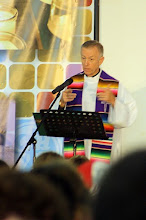
There are some (especially in Mobile and New Orleans) who think that Ash Wednesday is a gloomy after-thought to the party-times of Mardi Gras (which down here extend roughly from the middle of January onward). Even though it’s only that one day that is technically “Mardi Gras” (= “Fat” or “Decadent” Tuesday), that doesn’t stop the “good times rolling,” with parades, balls and various alternative activities of ‘celebration’).
But if I wish to call Ash Wednesday “Gras,” (in the sense of “Great,” not “Fat”), it is because I want to encourage people to think in a paradigm-shift about this season: Lent is not an appendage to partying; the party is a farewell to one kind of life-style, knowing that it’s time to embrace another.
Who are we, as people (collectively and individually)? Are we made for self-satisfaction and hedonism, or are we designed to be people who are capable of healthy introspection to see what’s really there, rejoice over the good, and resolve to reduce the bad?
When ashes are imposed, the traditional words are “Remember that you are dust, and to dust you shall return.” What part of this invocation is false? We know, deep down, that it has the ring of truth, and we want desperately to ignore it (we know we cannot dispute it). Repentance (that is, the recognition that there is much in us that needs correcting, and our willingness to correct it and/or have it corrected) is essential to what it means to be human, in need of a Savior.
Is it too early to bring up the thought of Ash Wednesday? Actually, no—EVERY day should be a Jour Gras for us, to make us face our reality, our limits—and our hope in Jesus Christ (without whom not only Ash Wednesday but Mardi Gras would have no sense or meaning).
Enjoy the time of these next few days, but remember who (and what) you are, and who (and what) you might could be…
But if I wish to call Ash Wednesday “Gras,” (in the sense of “Great,” not “Fat”), it is because I want to encourage people to think in a paradigm-shift about this season: Lent is not an appendage to partying; the party is a farewell to one kind of life-style, knowing that it’s time to embrace another.
Who are we, as people (collectively and individually)? Are we made for self-satisfaction and hedonism, or are we designed to be people who are capable of healthy introspection to see what’s really there, rejoice over the good, and resolve to reduce the bad?
When ashes are imposed, the traditional words are “Remember that you are dust, and to dust you shall return.” What part of this invocation is false? We know, deep down, that it has the ring of truth, and we want desperately to ignore it (we know we cannot dispute it). Repentance (that is, the recognition that there is much in us that needs correcting, and our willingness to correct it and/or have it corrected) is essential to what it means to be human, in need of a Savior.
Is it too early to bring up the thought of Ash Wednesday? Actually, no—EVERY day should be a Jour Gras for us, to make us face our reality, our limits—and our hope in Jesus Christ (without whom not only Ash Wednesday but Mardi Gras would have no sense or meaning).
Enjoy the time of these next few days, but remember who (and what) you are, and who (and what) you might could be…









